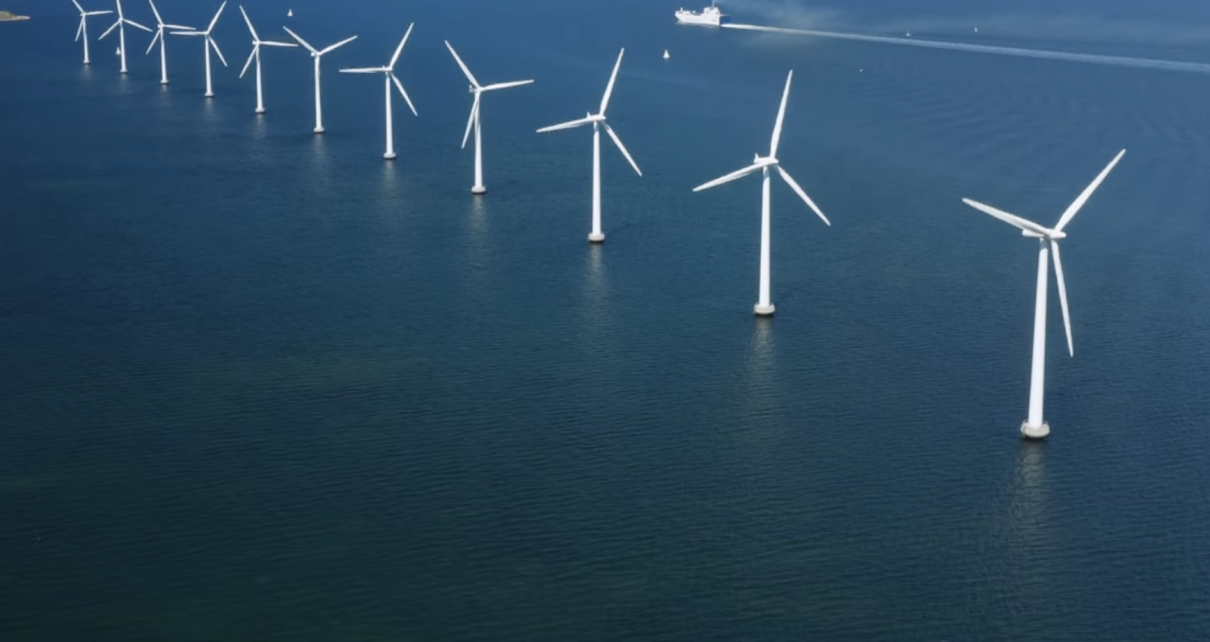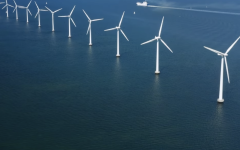
Offshore Wind farm. (Photo: Energy.ca.gov)
Ringside: Floating Offshore Wind – An Environmental Catastrophe
Direct destruction of our offshore marine environment are not the only environmental impacts of offshore wind
By Edward Ring, August 22, 2024 4:00 pm
 Last week we examined California’s plans to install between 2,500 and 10,000 floating offshore wind turbines approximately 20 miles off the coast of San Luis Obispo and Humboldt counties. The estimated cost to install 25 gigawatts of capacity, which equates to 10 gigawatts of steady power if adequate storage assets are available, is at least $100 billion. Those costs don’t include the necessary investments in storage assets or additional high voltage transmission lines. Nor do they include the costs to maintain these floating turbines in a hazardous environment.
Last week we examined California’s plans to install between 2,500 and 10,000 floating offshore wind turbines approximately 20 miles off the coast of San Luis Obispo and Humboldt counties. The estimated cost to install 25 gigawatts of capacity, which equates to 10 gigawatts of steady power if adequate storage assets are available, is at least $100 billion. Those costs don’t include the necessary investments in storage assets or additional high voltage transmission lines. Nor do they include the costs to maintain these floating turbines in a hazardous environment.
No other significant energy option costs this much. Even nuclear, at its falsely inflated construction costs, is less expensive. Natural gas electricity generation with CO2 sequestration included is four-times less expensive. Every imaginable “renewable” – solar, geothermal, and onshore wind – is far less expensive. We should not be doing this. It is special interest driven dysfunction at the highest levels of California politics, and it will squander hundreds of billions of dollars.
But beyond its eye-watering costs, offshore wind is an environmental catastrophe.
It doesn’t require scientific expertise to recognize that California’s treasured marine ecosystem will be disrupted by the presence of somewhere between 2,500 (at 10 megawatts each) and 10,000 (at 2.5 megawatts each) floating wind turbines. That will require between 7,500 and 30,000 tethering cables descending 4,000 feet to the sea floor, along with 2,500 to 10,000 high voltage cables. These power cables will either be individually descending 4,000 feet, or they’ll be connecting at shallow depths from one turbine to another, bundled in order to reduce the number of lines that have to traverse the 20 miles from wind farm to shore.
Imagine the impact on aquatic wildlife. Entanglements. Collisions. Broken cables. Electromagnetic fields. Low frequency noise. Sedimentation from anchor use. And so much more, all of it poorly understood.
When it comes to evaluating the environmental impact of offshore wind on whale populations, one would think environmental groups like Greenpeace would offer some criticisms. After all, the heroic original mission of Greenpeace was to save the whales. But today, instead of sending a reincarnation of the Rainbow Warrior to challenge offshore wind installers, the organization issues proclamations such as this: “Protecting whales means busting fossil-fueled myths about wind energy.”
The evidence that underwater sonar used to survey sites causes permanent damage to the ability of marine mammals to navigate and communicate is nearly indisputable. Inexplicable deaths of pilot whales off the coast of Scotland. Hundreds of deaths of minke, humpback and right whales off the coast of New England.
Off the east coast of the U.S., the areas selected for offshore wind farms have to be outside of heavily trafficked shipping routes. That is precisely where whales and other aquatic wildlife have congregated. Into these remaining sanctuaries comes noise from construction vessels, high frequency sonar mapping, and pile driving, releasing sound impacts up to 240 decibels. This is enough to permanently destroy hearing in marine mammals, which is fatal.
An August 2023 report released by a New England fishermen association summarizes research they completed on offshore wind projects. Their findings are stunning. Just the geographic extent of these proposed offshore wind projects is unprecedented. According to the report, “Federal regulators at the Bureau of Ocean Energy Management (BOEM) have designated almost 10 million acres for wind farm surveys and development.” That is over 15,000 square miles.
Not included in that allocation are the corridors where high voltage lines will have to cross the ocean floor to transfer electricity from the turbines to land-based power grids. The report found that “electromagnetic fields (EMFs) emanating from subsea cables appear to produce birth deformities in juvenile lobster.”
The report also found that wind farms “increase sea surface temperatures and alter upper-ocean hydrodynamics in ways scientists do not yet understand,” and “whip up sea sediment and generate highly turbid wakes that are 30-150 meters wide and several kilometers in length, having a major impact on primary production by phytoplankton which are the base of marine food chains.” There’s more.
Offshore wind turbines, after the high decibel disruption caused during surveying and installation, “generate operational noise in a low frequency range (less than 700 Hz) with most energy concentrated between 2 and 200 Hz. This frequency range overlaps with that used by fish for communication, mating, spawning, and spatial movement,” and “high voltage direct current undersea cables produce magnetic fields that negatively affect the drifting trajectory of haddock larvae by interfering with their magnetic orientation abilities.” Haddock are “a significant portion of U.S. commercial fish landings and are an important component of the marine food chain.”
Direct destruction of our offshore marine environment are not the only environmental impacts of offshore wind. The interior of the massive blades are typically made of balsa wood, which thanks to the surge in demand has led to Amazon rainforest being replaced with balsa plantations. By now it ought to be common knowledge that the quantity of minerals used to deploy green energy technologies is far greater than what is necessary for conventional energy. Using data from the International Energy Agency, geopolitical writer Peter Ziehan calculated the mineral requirements for offshore wind to be nearly 16,000 kilograms per megawatt, compared to less than 2,000 kg/MW for natural gas. The destructive impact of this mad rush to source minerals around the world so Americans can “go green” cannot be overstated.
Should this be of concern, there’s also the heavy carbon footprint of offshore wind. You have to take into account the carbon footprint of the mining, refining, manufacturing, shipping and installation. Then add to that the ongoing maintenance, sourcing, shipping and installing replacement parts. After no more than 20 years, the turbine and the blades will have to be replaced, with the old parts either disposed (you can’t recycle the massive blades) or recycled. And then there’s the additive impact of quick start backup natural gas power which when turned on and off abruptly to fill in for intermittent wind operates at a far lower efficiency, i.e., about twice as much CO2 emissions per megawatt-hour than when allowed to run as continuous baseload power. In fact, a September 2022 analysis by the US Bureau of Energy Management claimed that offshore wind would have “no measurable impact” on reducing so-called greenhouse gas.
In a must-watch video posted in February 2024, Lisa Knight, an M.D. and PhD and resident of Maine, delivers a 30 minute lecture to concerned local residents that surveys additional environmental harm that accompanies offshore wind farms. It is not possible in a few words to describe every detail of this dense, scrupulously researched presentation. All of it is relevant.
Suggesting that we need offshore wind because of the “urgency” of the climate crisis is an insult to the common sense of anyone who has studied these projects and compared them to every imaginable alternative. California needs to prioritize energy solutions that will do more good than harm.
- Ringside: CA GOP Just Blew $46 Million for Nothing – Here’s How They Can Avoid Repeating That Mistake in 2026 - December 24, 2025
- Ringside: Will the Delta Pumps Operate at Capacity this Winter? - December 18, 2025
- Ringside: Will Advocates for More Water Supply Projects Find Unity? - December 11, 2025



Another poorly thought-out energy “solution” by our virtue-signaling grifter class….
No thought to the undersea noise that these things will cause and screw up the undersea ecosystem…
I took SCUBA certification years ago, and they taught us that a light tap on our tanks with the butt of our dive knife could be used to signal our dive buddy from great distances…
What do the idiots that advocate for this disaster in the making think this will do to the environment they purport to save???
Not to mention the harsh saltwater environment that will corrode everything super quick and require lots of expensive maintenance…
Not just NO, but HELL NO!!!
Put in “another” Nuclear Plant right next to Diablo Nuclear Plant. Then, the Turbines won’t be needed. Our whales and marine life won’t be killed. We need marine life to survive. It would also add jobs to our community.
Put in “another” Nuclear Plant right next to Diablo or along the coast nearby such as Oceano, Guadalupe or Lompoc. These Turbines will be killing Whales and marine life, which we need to survive. It would also bring in more jobs to the community.
No bueno. Donde esta el “ecofreaks”?
Con Gleem!